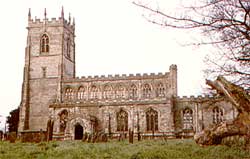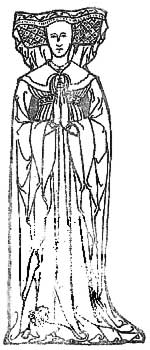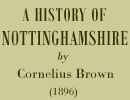< Previous | Contents | Next >
East Markham

St John the Baptist church, East Markham mostly dates from the 15th century and, according to Pevsner, is "the most splendid church in this part of the county". (A. Nicholson, 1982).
Near to Tuxford is East Markham, from which the renowned Markham family took their name. In the chancel of the church is the alabaster tomb of Judge Markham, who died in 1409, and near it was found a stone coffin with a lid level with the pavement. From the carving on the lid it is surmised that the coffin contained the remains of the judge’s first wife, Elizabeth, daughter of Sir Roger de Cressy, of Hodsock. His second wife was Milicent, daughter of Sir John de Bekeryng, and widow of Sir Nicholas Burdon, who was slain at the Battle of Shrewsbury in 1408. This lady, on the death of the judge, married Sir William Merying, and was buried at the east end of the south aisle. A stone inlaid with brass commemorating her contains the figure of a lady elaborately draped, her hands in an attitude of prayer.
It is believed that the judge lived in a manor-house not far from the church, and that a moat surrounded both buildings. His son, who became Lord Chief Justice, was born in this dwelling, and to their memories a beautiful stained glass window has been erected, upon which is the following inscription: ‘This window was rebuilt, 1885, to the glory of God, and in memory of Judge Markham, the founder of this church, who died A.D. 1409, and of his son, Sir John Markham, Lord Chief Justice of England, who died A.D. 1481, by some of their descendants.’
Both these men were eminent in their profession, and were highly distinguished for their ability and influence. Judge Markham drew up the legal instrument for the deposition of Richard II., and was one of the commissioners appointed to receive the crown which Richard resigned in favour of his rival. This great man’s son became Chief Justice in 1461, and risked the favour of the King by his famous ruling, which comes down to us till this day, that no subject can be arrested by the King for treason, ‘for if the arrest be illegal the party has no remedy against the King.’ It was in consequence of his decision to this effect in the case of Sir T. Cook, whom the King was anxious to convict, that Markham lost his position, and, retiring to Sedgbrook, near Grantham, died there in 1481.
In 1606 Sir Robert Markham sold the village partly to Robert Williamson and partly to William Hewett. But the members of the family continue to show an interest in the birthplace of their illustrious ancestors, and among the visitors to the village have been Dr. Markham, Archbishop of York, and his son, Dean Markham. Mr. Clements R. Markham, C.B., the popular Secretary of the Royal Geographical Society, wrote a history of the parish, which was sold in aid of the restoration of the church.

Brass of Dame Millicent Meryng, who died in 1419.
Mrs. Markham, the authoress of the ‘History of England,’ was the daughter of Dr. Cartwright, who was born in the adjoining village of Marnham, and was the inventor of the power loom. Having been brought up with two aunts at Mirfield Hall, Markham, she was married to the Rev. John Penrose, son of the incumbent of Fledborough, but took the nom de plume of Markham, to which she had been attached in her younger days. In 1837 the gifted authoress died, and was buried in Lincoln Minster; but there is a stained glass, window to her memory in East Markham Church.
There are also memorials to the Kirke family, who settled here in 1681, some of whom served the State in a military capacity. William III. passed through Markham on his way from Lincoln to Welbeck in 1695, the event being recorded in the parish register, the entries in which commence in 1561. There are few villages that have produced men who have more nobly vindicated the constitutional rights of Englishmen than the two famous judges to whom we have referred; and it must be confessed that Markham adds more than its share to the roll of illustrious names the possessors of which own Nottinghamshire as their native county.
